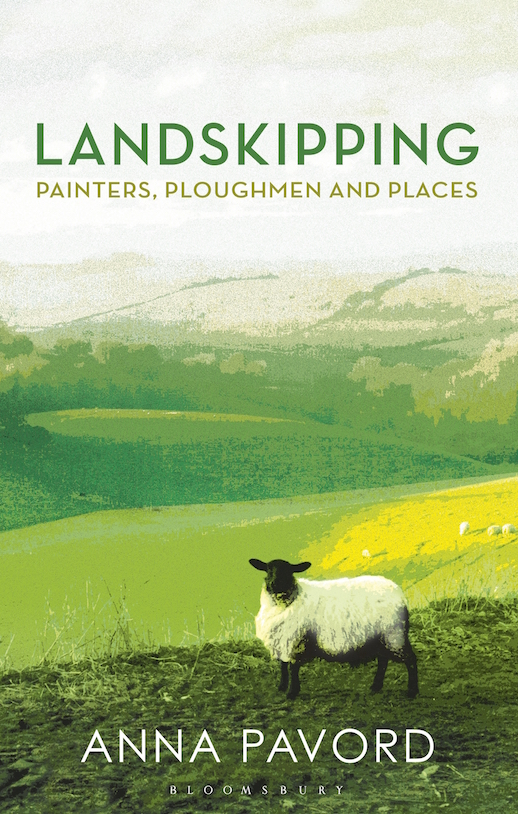Landskipping: Painters, Ploughmen and Places by Anna Pavord
(Bloomsbury, hardback. 272 pages, illustrated)
Review by Sue Brooks.
From my home on the Herefordshire/Gloucestershire border on a fine day, I can see the Black Mountains where Anna Pavord was born and grew up. The conical peak of the Sugar Loaf, the wooded gullies of the lower hills, the softly contoured farmland to the East: this is the landscape that entered her deeply and has shaped her life. Landskipping is a departure from the books about plants and gardens for which she is so well-known. She poses the question Why is it that some places call out to us, and give us sustenance, and other don’t? and sets out to explore, knowing her own answer, but eager to discover other points of view.
Taking the years 1750 -1880 as the focus, Pavord shows how views have changed. Part 1 covers the sublime and the picturesque: landscape as seen by artists and writers – those who were content to follow the rules laid down by William Gilpin, instructing them where to stand for the most rewarding experience – and those who broke free from such constraints. Constable, Richard Wilson, Turner and especially Samuel Palmer whose etchings appear as illustrations in the text. Pavord researches painstakingly, always preferring correspondence and notebooks for the immediacy of the language. Such an Abbey says Samuel Palmer in a letter to a friend on first seeing Tintern the lightest Gothic trellised with ivy and rising from a wilderness of orchards. Gilpin dismissed the same Abbey as disappointing, too regular, not enough terror.
I loved the story of Thomas Johnes who poured his life, his love and all his money into Hafod, a few miles inland of Aberystwyth in Cardiganshire. He combined the picturesque ideals of Gilpin with a deep concern for the welfare of the land and his tenants. A true romantic who pursued his vision against all advice and overwhelming odds. He planted over two million trees and built a Gothic mansion, but died with huge debts after the death of his only child in 1816 . All that remains, Pavord tells us is the setting – the hills, the streams, the rushing river that exerted such a strange, strong pull on Johnes.The house was demolished in 1956.
In Part 11 we are looking through completely different eyes. Those of the men, farmers mostly and small landowners, who produced Reports in 1794 for The General View of the Agriculture, county by county, with Observations on the means to its improvement.This is fascinating reading, showing how Industrialisation was advanced in some areas, and Enclosures just beginning to make their mark in others. We hear first-hand the recommendations for drainage, reclamation of waste land, better roads, canals, more efficient ploughs. A blueprint for using land for maximum profit with little regard for the lives of agricultural workers.
One thing leads to another, effortlessly. This is one of the great pleasures of Pavord’s style. It has the easy flow of a conversation between old friends, the kind that might be shared in the swing and stride of a long-distance footpath – ideas, recollections, enthusiasms, conjecture. She chooses her walking companions with care. The Board of Agriculture Reporters give way to William Cobbett, who was a passionate champion of agricultural labourers. He in turn tells us about his love of rooks and sheep in his favourite downland landscape – a mirror of Pavord’s feelings about her own. It brings the focus, at the end of a meticulously planned journey, back where it began. The particular patch in the far west of Dorset which called to Pavord as an adult – a place of small farms, deep valleys, steep hillsides, similar to the border country of her childhood – and sustains her to this day.
Part 111 tell us why. Exactly why – with the close attention to detail Pavord so much admires – a quiet view can create a slow-burning joy. She resists the temptation to romanticise. It is seen with an artist’s eye for colour and light, a farmer’s for the season, for livestock, the condition of the soil, and a historian’s for the human hands which have shaped it.
W.G.Hoskins in The Making of the English Landscape was pessimistic about the future. Not so Anna Pavord. If there is any character in “Landskipping” who matches her in heart and spirit, it is William Cobbett. His enthusiasm and energy are contagious. There was no end to the wonder and delight he found in the countless views which inspired him, especially his beloved Hampshire. But the youthful Samuel Palmer I feel, is her favourite.
Never forget the charm of running water. O! The playful heave and tumble of the lines of the hills here.
I have enjoyed this book immensely. It has been a tonic in the dark, cold January days.
Landskipping is available in the Caught by the River shop, priced at £18.
